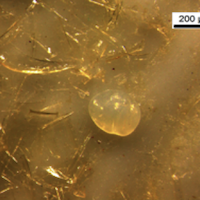Microplastics in vacuum packages of frozen and glazed icefish (Neosalanx spp.): A freshwater fish intended for human consumption

Accepted: 16 November 2021
HTML: 6
All claims expressed in this article are solely those of the authors and do not necessarily represent those of their affiliated organizations, or those of the publisher, the editors and the reviewers. Any product that may be evaluated in this article or claim that may be made by its manufacturer is not guaranteed or endorsed by the publisher.
It is widely accepted that human is exposed to microplastics through food consumption, however data occurrence in foodstuffs are still little and basically limited to seafood. In this study, the presence of microplastics was investigated in icefish (Neosalanx spp.) samples sourced from various mass-market retailers in Italy, supplied as frozen, glazed and vacuum-packed product. Icefish is a small freshwater fish widely imported in Europe from China as surrogate of other fish species subjected to commercial restriction, consumed whole after cooking in several culinary preparation. The samples (~10 g of icefish from each of the 40 packs tested) were digested using a solution of 10% potassium hydroxide and filtered through a 5 μm pore-size filter. Filters of the samples were observed under a stereomicroscope and the chemical composition of the items detected were analysed by FTIR spectroscopy. A total of 163 items were counted in 37 (92.5%) samples with a mean value of 0.42±0.28 items/g w.w. Fibers were the most detected morphotype and several plastic polymers, such as polypropylene, polyethylene, polyethylene terephthalate and polystyrene, were identified by FT-IR analysis. As store-bought samples, the sources of microplastics could be substantially related to contamination during food processing. However, an intravital exposure to microplastics present in the surroundings waters cannot be ruled out. More foodstuffs need to be investigated for microplastic presence. In this study, microplastic occurrence was reported in freshwater biota intended for human consumption sampled directly from supermarket contributing to the risk assessment of human exposure to microplastics via food consumption.
PAGEPress has chosen to apply the Creative Commons Attribution NonCommercial 4.0 International License (CC BY-NC 4.0) to all manuscripts to be published.


 https://doi.org/10.4081/ijfs.2021.9974
https://doi.org/10.4081/ijfs.2021.9974



